Search
- Page Path
-
- HOME
- Search
- Letter to the Editor
- Developmental and Behavioral Medicine
- Efficacy of social skills group intervention among children with mild autism spectrum disorder
- Lee Ling Low, Ker Yang Chua, Bih Hwa Ching
- Clin Exp Pediatr. 2024;67(7):368-370. Published online May 31, 2024
-

- Review Article
- Developmental and Behavioral Medicine
- Comprehensive evaluation of the child with global developmental delays or intellectual disability
- Abdullah Nasser Aldosari, T. Saeed Aldosari
- Clin Exp Pediatr. 2024;67(9):435-446. Published online May 29, 2024
-

· A detailed history and comprehensive physical examination remain the cornerstones for establishing a diagnosis of global developmental delay/intellectual disability (GDD/ID).
· Comprehensive surveillance and screening programs play a significant role in the early detection of GDD.
· Whole-exome sequencing is highly recommended as first- or second-line testing for individuals with idiopathic GDD/ID.
· Early intervention by a well-versed multidisciplinary team can significantly improve the outcomes and prognosis of GDD/ID.
- Letter to the Editor
- Neonatology (Perinatology)
- Pentraxin 3 as a marker of early-onset neonatal sepsis
- Safaa ELMeneza, Iman El-Bagoury, Hind Rayes, Amira Hassan
- Clin Exp Pediatr. 2024;67(6):312-314. Published online May 23, 2024
-

- Original Article
- Developmental and Behavioral Medicine
- Effectiveness of online responsive teaching in young children with developmental disabilities: a pilot study
- Jung Sook Yeom, Jeongmee Kim
- Clin Exp Pediatr. 2024;67(6):303-311. Published online May 21, 2024
-

Question: Does online responsive teaching (RT) impact children's and parents’ emotions and behaviors, and do parents find it satisfactory?
Finding: Online RT significantly improved children's pivotal and problem behaviors, decreased parenting stress, and enhanced parental interactive styles with high satisfaction.
Meaning: This pilot study's findings suggest that online RT can enhance child outcomes, offering accessible interventions amid challenges such as limited access and pandemics.
- Endocrinology
- Kisspeptin and DLK1 levels for monitoring treatment of girls with central precocious puberty
- Witchuwan Onsoi, Nattakarn Numsriskulrat, Suphab Aroonparkmongkol, Vichit Supornsilchai, Khomsak Srilanchakon
- Clin Exp Pediatr. 2024;67(6):296-302. Published online May 21, 2024
-

Questions: Can the serum levels of kisspeptin and DLK1 be potential biomarkers for monitoring the treatments for central precocious puberty (CPP)?
Findings: There were no significant differences in the baseline serum kisspeptin and DLK1 levels in CPP girls compared to girls with premature thelarche (PT). After 6 months of GnRH analogue treatment in CPP girls, median serum kisspeptin levels decreased, while median serum DLK1 levels increased compared to baseline.
Meanings: Serum levels of kisspeptin and DLK1 may serve as novel biomarkers for monitoring the efficacy of treatments for CPP.
- Editorial
- Neurobehavior
- Importance of pediatrician’s role in preventing positional plagiocephaly
- Hee-Jeong Kang
- Clin Exp Pediatr. 2024;67(6):294-295. Published online May 21, 2024
-

· Plagiocephaly is characterized by the asymmetrical shape of a baby’s head.
· Since positional plagiocephaly is associated with developmental delay and further musculoskeletal problems, early detection allows for timely intervention and prevents worsening of the condition.
· Pediatricians can educate parents about proper head positioning and encourage supervised tummy time during awake hours.
- Review Article
- Hematology
- Iron deficiency in children with a focus on inflammatory conditions
- Na Hee Lee
- Clin Exp Pediatr. 2024;67(6):283-293. Published online May 21, 2024
-

· Iron deficiency has important effects on neurodevelopment and the immune system in children.
· Hepcidine plays an important role in iron homeostasis.
· Diagnosis and treatment of iron deficiency in chronic inflammatory disease are important for patients' quality of life and disease course.
- Other
- Use of virtual reality in children in a broad range of medical settings: a systematic narrative review of recent meta-analyses
- Emily Antonovics, Grammatina Boitsios, Thomas Saliba
- Clin Exp Pediatr. 2024;67(6):274-282. Published online May 21, 2024
-

· Virtual reality (VR) is becoming increasingly common for entertainment and in medical settings.
· VR is useful for treating children with cerebral palsy.
· VR can help with attention deficit/hyperactivity disorder symptoms.
· VR can decrease pain perception in children undergoing burn wound care.
· VR can reduce preoperative anxiety.
· VR can reduce fear and pain during needle-involving procedures.
- Allergy
- Action-plan and as-needed therapy in allergic rhinitis
- Hyeon-Jong Yang
- Clin Exp Pediatr. 2024;67(6):267-273. Published online May 21, 2024
-

· The guidelines may not work in the real world.
· An action-plan reflecting patient’s severity and variable of symptoms, values and preferences as well as the benefits and harms of treatment, may be a useful alternative.
· The action plan and as-needed therapy must include the following elements: when, what, how, and why.
· Action plan and as-needed therapy can help patients manage their symptoms more effectively.
- Editorial
- Infection
- Preventing bloodstream infections in children after liver transplantation
- Young June Choe
- Clin Exp Pediatr. 2024;67(11):599-600. Published online April 18, 2024
-
Liver transplantation (LT) is crucial for children with end-stage liver diseases, yet bloodstream infections (BSI) pose significant risks, despite medical advancements. Immunosuppressants, essential for preventing organ rejection, heighten infection susceptibility. Understanding BSI organisms is vital due to antimicrobial resistance. Pediatric LT recipients have unique risk factors, demanding tailored preventive measures. This systematic review on bacterial BSI emphasizes the urgency of effective prevention strategies, considering the high incidence and distinct organism profile. Further research is vital for optimizing antibiotic management and improving outcomes for this vulnerable population.
- Immunology
- Utility of eosinophil granule proteins in management of pediatric chronic cough
- Chang-Keun Kim
- Clin Exp Pediatr. 2024;67(10):519-520. Published online April 17, 2024
-

· Pediatric chronic cough often involves eosinophilic inflammation; however, objective measurements are not routinely used in treatment decisions.
· Accurate biomarkers of eosinophil activity, such as eosinophil-derived neurotoxin (EDN) and cationic proteins (ECP), should be used. EDN, which overcomes the shortcomings of ECP, recently received approval for use in Korean healthcare settings.
· EDN and ECP can play a role in treatment period and drug selection decisions.
- Original Article
- Pulmonology
- Oligohydramnios affects pulmonary functional/structural abnormalities in school-aged children with bronchopulmonary dysplasia
- Jeong Eun Shin, Soon Min Lee, Mi-Jung Lee, Jungho Han, Joohee Lim, Haerin Jang, Ho Seon Eun, Min Soo Park, Soo Yeon Kim, Myung Hyun Sohn, Ji Ye Jung, Kyung Won Kim
- Clin Exp Pediatr. 2024;67(5):257-266. Published online April 16, 2024
-
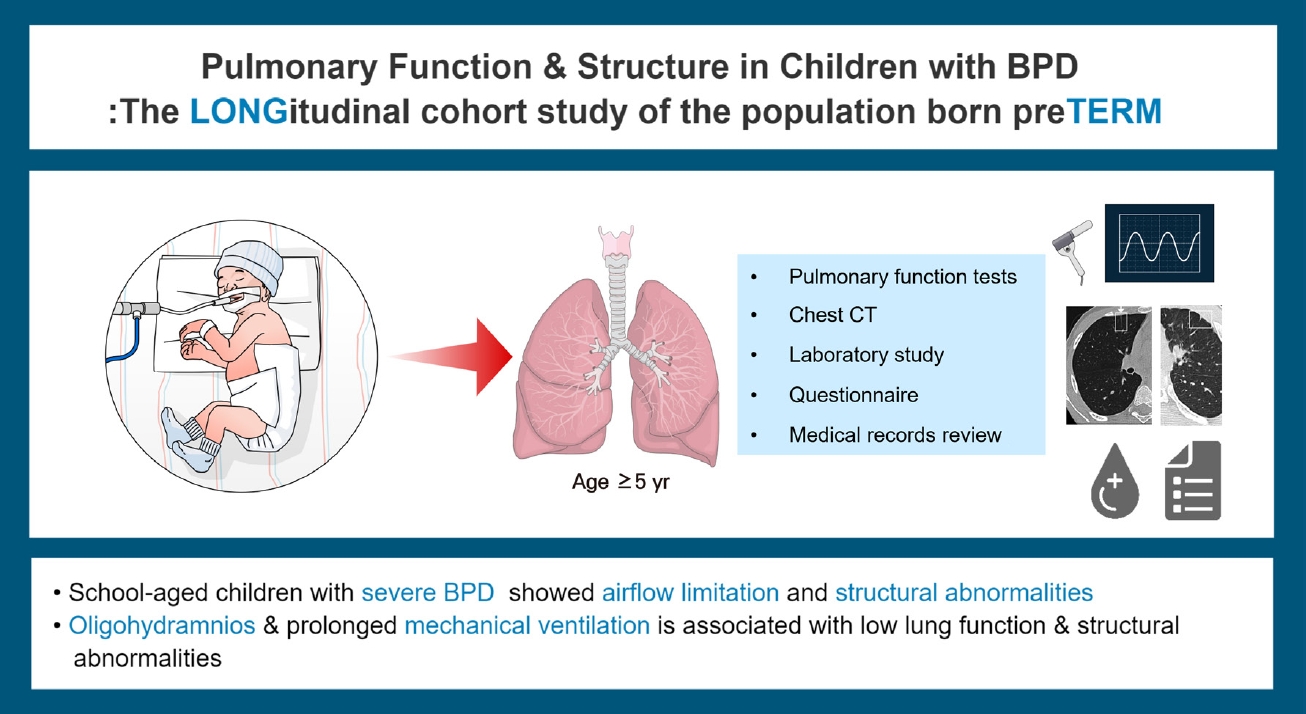
Question: Is bronchopulmonary dysplasia (BPD) associated with functional/structural abnormalities later in life?
Finding: School-aged children with severe BPD had abnormalities on pulmonary function tests and lung computed tomography despite no subjective respiratory symptoms; however, only prenatal oligohydramnios and prolonged ventilator use were associated with abnormal lung function.
Meaning: Long-term monitoring of preterm infants’ lung health is essential, especially for those with prenatal oligohydramnios or prolonged ventilator use.
- Review Article
- Infection
- Incidence, causative organisms, and risk factors of bloodstream infections in pediatric liver transplant patients: a systematic review
- Mohamad Shieb, Rand Hasanain, Zara Arshad, Faisal A. Nawaz, Rahul Kashyap, Eric J. Stern
- Clin Exp Pediatr. 2024;67(9):427-434. Published online April 5, 2024
-

The overall incidence of bloodstream infections was 23.5%. Gram-negative organisms occur at a much higher rate in pediatric liver transplant recipients then that the general pediatric population. However, when comparing pediatric and adult liver transplant recipients Gram-positive organisms occur with a much higher rate in the pediatric population highlighting the importance of early and broad spectrum antimicrobial coverage when bloodstream infections are suspected.
- Original Article
- Neonatology (Perinatology)
- Effect of vitamin E supplementation on bilirubin levels in infants with hyperbilirubinemia: a double-blind randomized clinical trial
- Mojtaba Cheraghi, Maziar Nikouei, Majid Mansouri, Siros Hemmatpour, Yousef Moradi
- Clin Exp Pediatr. 2024;67(5):249-256. Published online March 26, 2024
-

Question: Is vitamin E a viable therapeutic option for managing neonatal hyperbilirubinemia?
Finding: This randomized clinical trial examined the effects of oral vitamin E supplementation on bilirubin reduction (primary outcome), phototherapy duration, and length of hospital stay (secondary outcome) in 138 infants.
Meaning: Infants administered vitamin E versus placebo demonstrated similar reductions in bilirubin levels and length of hospital stay.
- Editorial
- Neurology
- Impact of COVID-19 pandemic on clinical features of benign convulsions with mild gastroenteritis
- Jon Soo Kim
- Clin Exp Pediatr. 2024;67(9):456-458. Published online March 25, 2024
-

· The frequency of benign convulsions with mild gastroenteritis (CwG) was not significantly influenced by the pandemic.
· The coronavirus disease 2019 pandemic has further diversified the etiologic enteric viral pathogens of CwG.
- Letter to the Editor
- Neonatology (Perinatology)
- Assessment of iron status and red cell parameters in healthy term small for gestational age neonates at birth
- Arif Hossain, Shorna Rahman, Shahana Akter, Ismat Jahan, Sanjoy Kumer Dey, Abdul Mannan, Mohammod Shahidullah
- Clin Exp Pediatr. 2024;67(4):221-223. Published online March 19, 2024
-
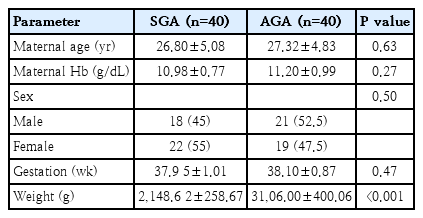
- Original Article
- Neurology
- Changes in frequency of benign convulsions with mild gastroenteritis and their viral causes before and during the COVID-19 pandemic: a single-center study
- Hyejin Na, Sanghoon Lee, Seo Hee Kim, Young Ok Kim
- Clin Exp Pediatr. 2024;67(4):213-220. Published online March 19, 2024
-

Question: Did coronavirus disease 2019 (COVID-19) affect the frequency, seasonal variation, or virus type of benign convulsions with mild gastroenteritis (CwG)?
Findings: We compared 41 cases of CwG before and during the COVID-19 pandemic. After March 2020, frequency did not change significantly (18 patients vs. 23 patients), seasonal variation was lost, and number of cases of enteric adenovirus-associated CwG increased (1 cases vs. 7 cases).
Meaning: The COVID-19 pandemic affected CwG.
- Nutrition
- Effect of probiotics plus zinc supplementation on clinical outcomes of infants and children with acute infectious diarrhea: a randomized controlled trial
- Deldar Morad Abdulah, Saad Jbraeil Sulaiman, Zaid Waad Ahmed
- Clin Exp Pediatr. 2024;67(4):203-212. Published online February 19, 2024
-

Question: Does zinc supplementation along with probiotics affect disease severity or clinical outcomes of children with acute diarrhea?
Findings: This study indicated that zinc supplementation and probiotics had no effect on clinical improvement or disease severity among pediatric patients with acute diarrhea.
Meaning: Children who received probiotics plus zinc recovered faster than those who received probiotics only.
- Letter to the Editor
- Pulmonology
- Metabolic syndrome and pulmonary dysfunction in asthmatic children during the COVID-19 pandemic
- Jue Seong Lee, Sang Hyun Park, Yoon Lee, Seunghyun Kim, Wonsuck Yoon, Young Yoo
- Clin Exp Pediatr. 2024;67(3):168-170. Published online February 19, 2024
-
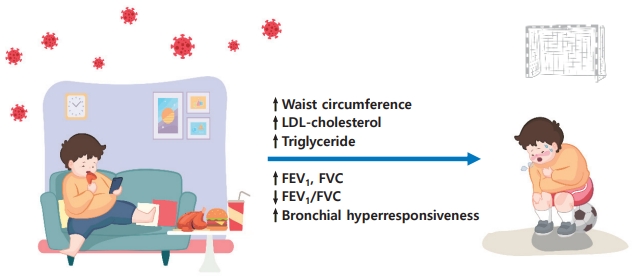
- Original Article
- Neonatology (Perinatology)
- Oral administration of bone marrow-derived mesenchymal stem cells attenuates intestinal injury in necrotizing enterocolitis
- Yeong Seok Lee, Yong Hoon Jun, Juyoung Lee
- Clin Exp Pediatr. 2024;67(3):152-160. Published online February 19, 2024
-
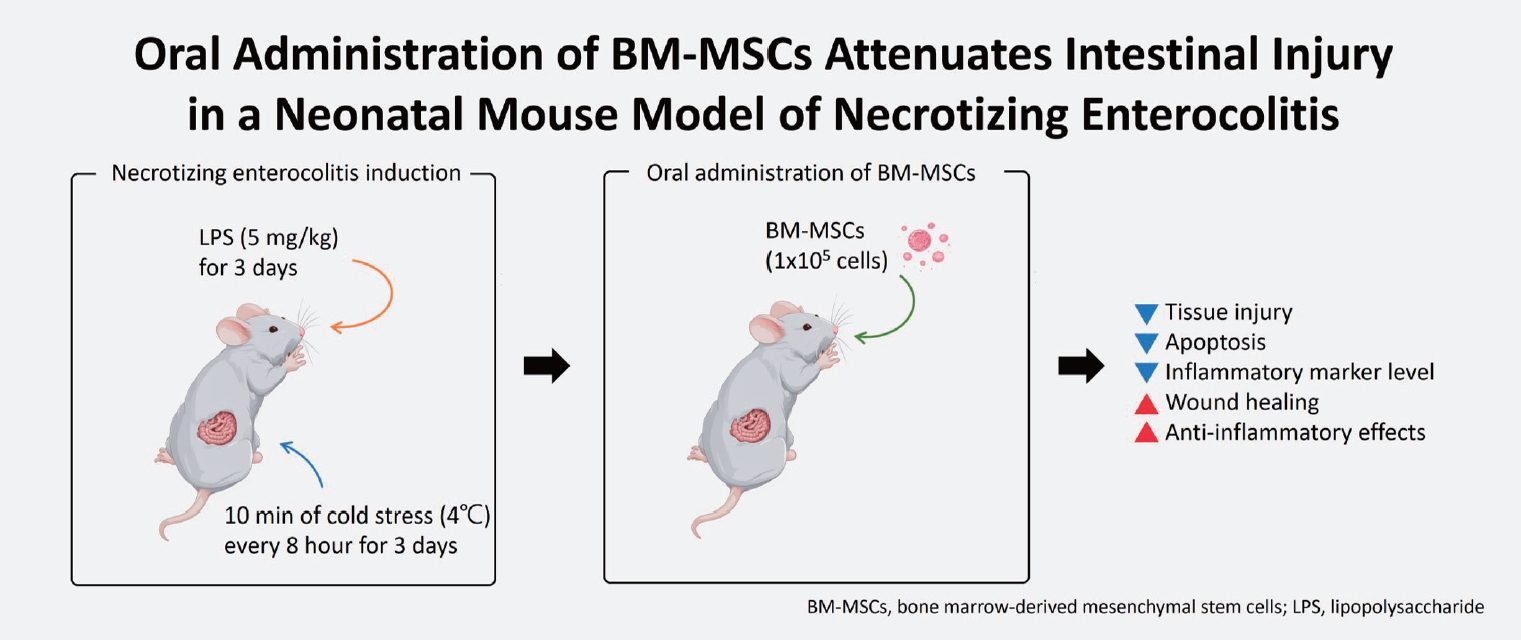
Question: What is the optimal dose of bone marrow-derived mesenchymal stem cells (BM-MSCs) for treating necrotizing enterocolitis (NEC), and is orally administered BM-MSC effective?
Findings: High (1×106 cells) or multiple BM-MSC doses showed similar effects as low (1×105 cells) doses of intraperitoneally administered BM-MSCs. Furthermore, orally administered BM-MSCs were as effective as intraperitoneally administered BM-MSCs.
Meaning: Orally administered low-dose BM-MSCs are a potential treatment for NEC.
- Editorial
- Critical Care Medicine
- Is it possible to provide palliative care to pediatric patients with neurological diseases?
- Young-Hoon Kim
- Clin Exp Pediatr. 2024;67(8):403-404. Published online February 15, 2024
-
· Patients with neurological diseases often require external mechanical support to maintain mechanical ventilation or supply.
· Little has been done to help the families of affected children make difficult decisions that carry significant physical and psychological consequences.
· The establishment of a department that provides pediatric palliative care for neurological patients should be considered.
- Letter to the Editor
- General Pediatrics
- Vitamin B12 deficiency in anemic children before versus after age 2 years: a form of hidden hunger in India
- Sahil Goel, Ruchika Bhatnagar, Anita Kumari, Brig Prem Lochan Prasad, Lahar Sahai
- Clin Exp Pediatr. 2024;67(2):116-118. Published online January 24, 2024
-
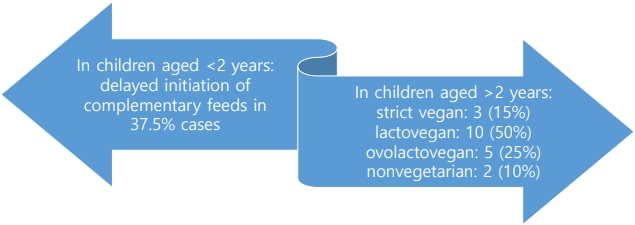
- Editorial
- Endocrinology
- Nonalcoholic fatty liver disease in children and adolescents
- Hae Sang Lee
- Clin Exp Pediatr. 2024;67(2):90-91. Published online January 24, 2024
-
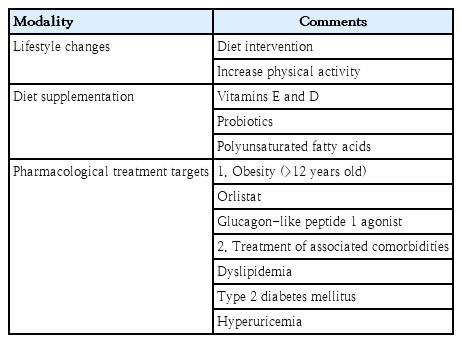
· With the increase in childhood obesity, nonalcoholic fatty liver disease (NAFLD) has become a concern in recent years.
· NAFLD is strongly associated with insulin resistance.
· Lifestyle modifications are the mainstay treatment for NAFLD.
- Review Article
- Pulmonology
- Evidence-based management guidelines for noncystic fibrosis bronchiectasis in children and adolescents
- Eun Lee, Kyunghoon Kim, You Hoon Jeon, In Suk Sol, Jong Deok Kim, Taek Ki Min, Yoon Ha Hwang, Hyun-Ju Cho, Dong In Suh, Hwan Soo Kim, Yoon Hee Kim, Sung-Il Woo, Yong Ju Lee, Sungsu Jung, Hyeon-Jong Yang, Gwang Cheon Jang
- Clin Exp Pediatr. 2024;67(9):418-426. Published online January 23, 2024
-

· We suggest offering long-term macrolides to children with noncystic fibrosis bronchiectasis with frequent exacerbations (conditional recommendation, moderate quality of evidence).
· We do not recommend the routine use of mucolytic agents, inhaled corticosteroids, or nonsteroidal anti-inflammatory drugs to prevent exacerbation of bronchiectasis in children (inconclusive, very low quality of evidence).
· We recommend the use of nebulized hypertonic saline to prevent exacerbations and improve the lung function of children with noncystic fibrosis bronchiectasis (weak recommendation, moderate quality of evidence).
- Original Article
- Cardiology
- Effect of face mask on pulmonary artery pressure during echocardiography in children and adolescents
- Alireza Ahmadi, Mohammad Reza Sabri, Zohreh Sadat Navabi
- Clin Exp Pediatr. 2024;67(3):161-167. Published online January 23, 2024
-
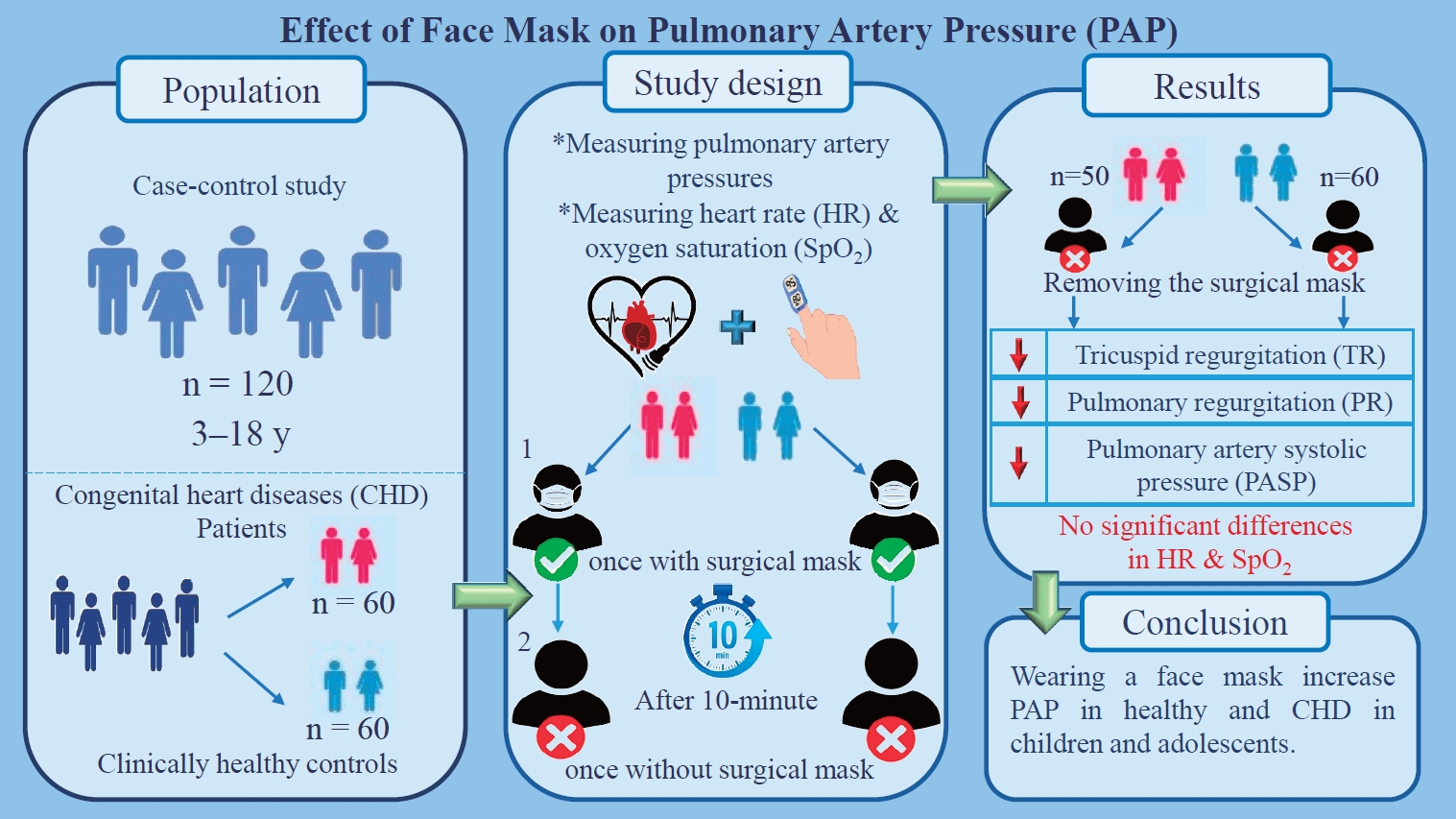
Question: Can face masks alter pulmonary pressure in children and adolescents with and without congenital heart disease?
Findings: Mask removal during echocardiography (ECHO) reduced pulmonary pressure.
Meaning: These findings suggest that face masks should be removed during ECHO in children and adolescents.
- Review Article
- Nephrology (Genitourinary)
- Effects of diethylene glycol contamination of pharmaceutical products on unexplained acute kidney injury in children: a systematic review
- Sani Rachman Soleman, Muhammad Luthfi Adnan, Hilmi Ardian Sudiarto, Satria Bintang Mahathma, Alya Ayu Tazkia, Hana Afifah Firdaus, Alfreda Amelia Khotijah, Miranti Dewi Pramaningtyas, Emi Azmi Choironi
- Clin Exp Pediatr. 2024;67(8):395-402. Published online January 4, 2024
-

A recent unexplained acute kidney injury (AKI) outbreak due to pharmaceutical product contamination with diethylene glycol (DEG) raises public attention. Our study revealed that DEG-contaminated paracetamol causes unexplained AKI in children. However, paracetamol is not the only contaminated drug. Other drugs, such as cough expectorants, antihistamines, and sedatives, can also be affected. Other chemicals, such as ethylene glycol and propylene glycol, can also contribute to poisonings.
- Editorial
- Neonatology (Perinatology)
- Exploring the role of laryngeal masks in neonatal resuscitation
- Euiseok Jung
- Clin Exp Pediatr. 2024;67(5):247-248. Published online December 28, 2023
-
· Laryngeal masks (LMs) offer stable airway access and skill retention advantages, making them promising alternatives to positive-pressure ventilation in neonatal care.
· The ease of teaching LM insertion techniques to less experienced providers addresses the need for swift intervention and skill retention.
· Careful consideration of the benefits and challenges of LMs is essential in determining their effective integration into enhanced neonatal resuscitation protocols.
- Impacts of maternal COVID-19 during pregnancy on neonatal health and epidemiology
- Jae Woo Lim
- Clin Exp Pediatr. 2024;67(3):149-151. Published online December 28, 2023
-

Newborns born to mothers infected with coronavirus disease 2019 (COVID-19) should be closely monitored for respiratory disorders, such as transient tachypnea of the newborn, regardless of their COVID-19 test results. Further research is required of the development of infants born to mothers with COVID-19. The trends in Korea's birth rate and infant mortality rates have not been significantly affected by COVID-19.
- Clinical Note
- Neurology
- Expanding association between BICD2 variants and brain malformations and associated lissencephaly
- Jaeso Cho, Haeryung Kim, Seoungbok Lee, Jihoon G Yoon, HyeJin Kim, Minhye Kim, Seoyun Jang, Woojoong Kim, Soo Yeon Kim, Jong Hee Chae
- Clin Exp Pediatr. 2024;67(1):54-56. Published online December 21, 2023
-

- Original Article
- Adolescence Medicine
- Relationship between inflammatory biomarkers and insulin resistance in excess-weight Latin children
- Mariano Nicolás Aleman, María Constanza Luciardi, Emilce Romina Albornoz, María Cristina Bazán, Adela Victoria Abregú
- Clin Exp Pediatr. 2024;67(1):37-45. Published online December 21, 2023
-

Question: What is the prevalence of insulin resistance (IR) in excess-weight Latin children, and can proinflammatory biomarkers predict it?
Finding: IR prevalence was elevated and tumor necrosis factor- α, interleukin-6, monocyte chemoattractant protein- 1, soluble CD40 ligand, and high-sensitivity C-reactive protein levels were increased in excess-weight Latin children. However, none predicted IR status.
Meaning: These inflammatory biomarkers were unable to predict IR status. Therefore, further investigations are necessary.
-

-
-
6.02024CiteScore98th percentilePowered by
-
Impact Factor3.6
-
- TOPICS
- ARTICLE CATEGORY
- Editorial Office
-
Korean Pediatric Society
#1606 Seocho World Officetel, 19 Seoun-ro, Seocho-ku, Seoul 06732, Korea
Tel: +82-2-3473-7306 Fax: +82-2-3473-7307 E-mail: office@e-cep.org
Clinical and Experimental Pediatrics is an open access journal. All articles are distributed under the terms of the Creative Commons Attribution NonCommercial License (http://creativecommons.org/licenses/by-nc/4.0/)
Copyright © 2025 by Korean Pediatric Society.











